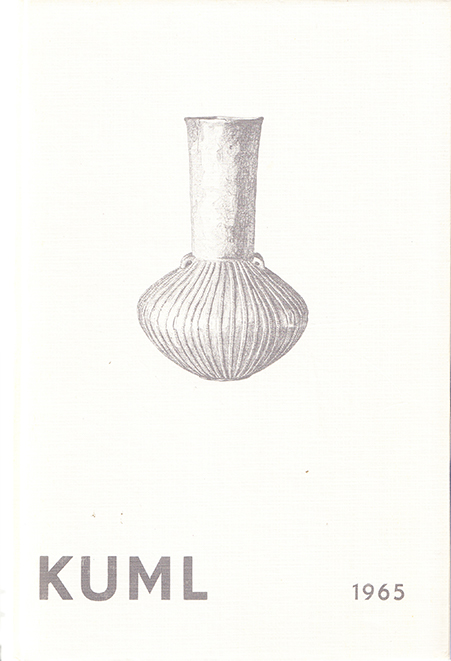Arabiens arkæologi
DOI:
https://doi.org/10.7146/kuml.v15i15.104497Nøgleord:
Arabien, arabia, trucial, Sharjah, fujairaResumé
Gulf of Oman Coast
The greater part of the Arabian coast of the Gulf of Oman lies in the territory of the Sultanate of Muscat and Oman, in which permission to carry out archeological reconnaissance has not yet been received. However, between the mountainous promontory of Cape Musandam to the north and the Batina coast to the south lies a stretch of coast belonging to the Trucial Sheikhdoms of Sharjah and Fujaira. Here, between the mountains running down to the sea, there are three broad alluvial valleys, from north to south those of Dibba, Khor al-Fakhan and Kalba-Fujaira. Taking advantage of a visit to the expedition team working in Abu Dhabi Professor Glob and Geoffrey Bibby made a three-day trip to the northernmost of these valleys, that of Dibba, in which troops of the Trucial Oman Scouts, in the course of digging practice trenches, had two years before discovered quantities of supposedly prehistoric remains, sherds of pottery and of steatite vessels. The assistance of the Trucial Oman Scouts in enabling this trip to be made and in guiding us to the sites discovered is here gratefully acknowledged.
The descent from Musafi, the village at the crest of the mountain chain, to the coast of the Indian Ocean is by way of a hair-raising gorge where a jeep must pick its way, like a mule, among and over 4-foot boulders, with sheer cliffs rising on either hand. Abruptly the canyon turns a corner, and in front lies level gravel, a plain of sparse grass stretching the six miles to the sea, formed of the outwash of debris from the mountain gorges such as that just traversed.
It was in this featureless plain, about one kilometre southwest of Gharfa - which is a largish village or small town south of and almost adjoining the coastal town of Dibba - that the trenches of the Scouts had struck, at a depth of about a metre, a number of large unshaped stones, and among them bones, potsherds and pieces of steatite vessels. Two years of sand-drift had since then obscured what had never been designed as an archeological excavation, and the weathered sides of the trench, even with energetic scraping, gave no certain indication, in the uniform gravel, of the sides of pits or graves. The potsherds and other remains found protruding from the sides of the trench were at a uniform level close to the bottom of the trench, and were found over its whole length, perhaps 30 metres. The general impression was of an occupation level, though the possibility that the trench was dug through a close-packed cemetry could not be dismissed.
A collection of representative potsherds was made, while all fragments of steatite were collected. In addition a bronze arrowhead, 8 cms. long, leaf-shaped and with a tang and central rib, was found, as well as two buttons of shell, one a simple rough circle 2.4 cms. in diameter with a central hole, and the other 5 cms. in diameter with a central hole ringed by two incised circles and surrounded by six half-bored holes similarly ringed.
The pottery showed a preponderence of deep bowls with a slight shoulder below a 2-cm. deep slightly outturned rim. Most of the ten fragments of these rims, all of different bowls, were painted with a cross-hatching of black or red on a dark plum-red ground. Neither the ground colour nor the decoration extended further down than the shoulder. Base and side sherds, probably of these bowls, were in some cases decorated on the inside with radial wavy lines, combined in one case with hatched triangles radiating out from the centre of the bottom. The decoration was in black on a red wash, or in red on the original light buff. Burnishing occured on a very few sherds, while one rimsherd showed the beginnings of an open spout. There were in addition sherds of two simpler, shallower bowls, and two sherds of vase-shaped vessels with out-rolled rims, one with a bridged spout. These were undecorated.
The majority of the steatite sherds were of beehive-shaped pots, 8-10 cms. in height, with incised linear decoration, in one case formed of minutely zigzagging lines. There was also one sherd with a protuberance suggesting an original vessel with three or four knobfeet, and a piece of a circular lid with a sawtooth ornamentation.
Dating of this assemblage is not at the moment possible. The bronze arrowhead, and the complete absence of glazed ware, suggests a pre-Islamic date, probably First Millennium BC or earlier. The absence from the steatite vessels of the dot-and-circle motif found on practically speaking every steatite vessel of the Umm an-Nar and the Barbar cultures would suggest a date later than the beginning of the Second Millennium BC, while there was similarly no resemblance in the pottery to that found in the later gravemounds of Buraimi, and dated by the sword found in one of them (Kuml 1964) to about 1200-1300 BC. If one should risk a guess for the Dibba complex it would therefore be somewhere between 1000 and 500 BC. But such a guess would be hazardous in the extreme.
A second site, 1 ½ kms. south of Gharfa, where a square well had recently been cleaned out, yielded coarse pottery of indeterminate character, and a number of steatite fragments, all of shallow bowls. This complex was even less dateable than the former, and no guess will here be hazarded.
Geoffrey Bibby.Downloads
Publiceret
Citation/Eksport
Nummer
Sektion
Licens
Fra og med årgang 2022 er artikler udgivet i Kuml med en licens fra Creative Commons (CC BY-NC-SA 4.0).
Alle tidligere årgange af tidsskriftet er ikke udgivet med en licens fra Creative Commons.


